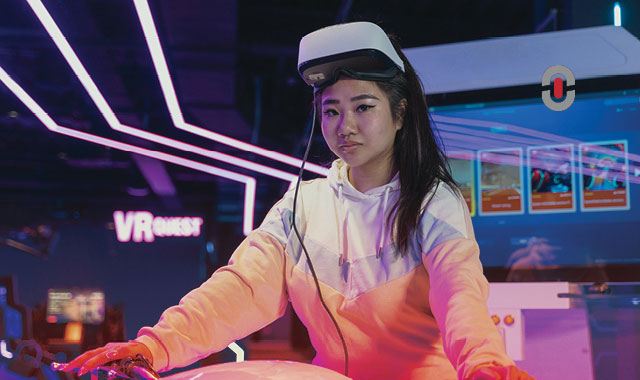Just like most industries in the world are affected by developments in technology, the translation industry is not far behind with the introduction and continuous developments in AR and VR. But what are AR and VR? While both deal with enhancements to our real world in a virtual setting, there are some important differences to keep in mind. And moreover, it’s important to be aware of how AR and VR will or are likely to affect the future of the translation industry. So, without further ado, let’s explore this fascinating topic in more detail below.
What is the difference between AR and VR?
Although AR and VR might seem like something out of a futuristic sci-fi movie, they are all around us and a part of our daily lives. We simply need to be aware of these to find out that we actually implement them in our daily lives. But what do AR and VR stand for? Whereas AR stands for augmented reality, VR means virtual reality. If you thought these terms sound and look similar and therefore they must mean the same thing, you’d be wrong.
For example, as the name suggests, AR is reality taken from our real world, which is literally augmented and enhanced. This means the capability of having an almost real-world experience with enhancements added to it. VR or virtual reality, on the other hand, is the immersion into an entirely new and different reality that is often used by gamers to immerse themselves in video games.
But where else are AR and VR used? You’d be surprised. From changing your background when you’re having a virtual meeting to determining the look of the interior of your home with new furnishings before you even purchase that new couch, AR and VR can also extend to seeing what you’ll look like with new haircut, new nail polish or a manicure/pedicure, as well as in education and learning. But perhaps crucially, its use is becoming increasingly used in the translation industry.
How can you translate content with AR and VR?
Because of the widespread uses of AR and VR, particularly in the translation industry, you might be wondering how content can actually be translated using these technologies. The answer lies in new technological developments, created and developed by industry giants such as Google and Xiaomi. Google, for example, has introduced virtual reality glasses. Although it is not yet clear when they will be rolled out on the mass market, it is clear that they will revolutionize the translation industry.
How? Because by putting on such virtual reality glasses, users will be able to see translations and transcriptions of one language into the desired source language spoken by the wearer. Google integrates its well-developed Google Translate platform with these glasses to bring translations that much closer to ordinary people. This can ultimately help shape travel, education, business, and many other areas of life.
But behind these technological developments – among which are also VR contact lenses – is the need for a massive infrastructure of quality translated content. This means having numerous translators, proficient in multiple languages, and who are capable of translating to a high quality, professional level. This “database” of knowledge, information, and language translations can then be applied to multiple industries.
However, in addition to this, when organizations seek to introduce content to their employees, customers, or even stakeholders, AR and VR can really help take their offerings several notches above their competitors. For example, courses in business, online safety, education classes, and so much more will need to be translated and localized to high professional standards to ensure that the AR and VR experience of the user is as seamless, streamlined, and natural as possible.
What does the future of translation technology look like?
Despite their futuristic appearance, AR and VR are already a part of the translation industry. This is especially the case when it comes to companies and organizations which are seeking to implement this technology into their offerings – both for their employees and end users. However, this task will require some important prerequisites to be put in place before a quality translation of any type of content can take place. These include, but are not limited to:

- High-quality translations for AR and VR projects: when dealing with extended reality, an organization must keep in mind that there is no room for error. Every piece of content, every word and utterance needs to be accurately translated to ensure that they do not alienate their end users with poorly translated and poorly localized content. This is crucial irrespective of whether you’re providing educational courses to international students online or you’re helping someone with the service of their new automobile. Quality translations will be vital at every step of the way. This will require checks and balances and quality control processes to be put in place and adhered to rigorously.
- Specialist and subject-specific knowledge: apart from ensuring that a translation for AR and VR is of a high-quality standard and as accurate and flawless as possible, the human translators behind such projects much have specialist and subject-specific knowledge. This means that if you’re offering a course on business management or on a legal subject, the translator involved in the project must have knowledge of that particular subject in addition to being able to translate it from the source to the target language effectively.
- Knowledge of the inner workings of AR and VR: finally, the future of the translation industry as it relates to AR and VR would not be complete without intricate knowledge of the deeper workings of this technology. If a translator doesn’t have the final goal and end picture in mind, they may produce content that is not relevant, factual, or accurate for usage and implementation.
Therefore, with these three points in mind, we see that the translation industry requires the services of highly skilled translators who are also familiar with the inner workings of AR and VR in order to produce high-quality outputs.
The way forward with AR and VR
Although seemingly slow and steady, the infiltration of AR and VR into our daily lives is here to stay. This means that many organizations, which are seeking to expand across global borders, will have a lot of work ahead of them to streamline and introduce their AR and VR solutions to multiple language audiences. As a result, the translation industry is likely to see growing demand for translation services, particularly for AR and VR. Consequently, taking the right steps and being as thoroughly prepared as possible for the future of translation will be crucial. This will involve enlisting the services of professional translators with subject-specific knowledge, as well as those who are familiar with the inner workings of AR and VR as it relates to translations.
